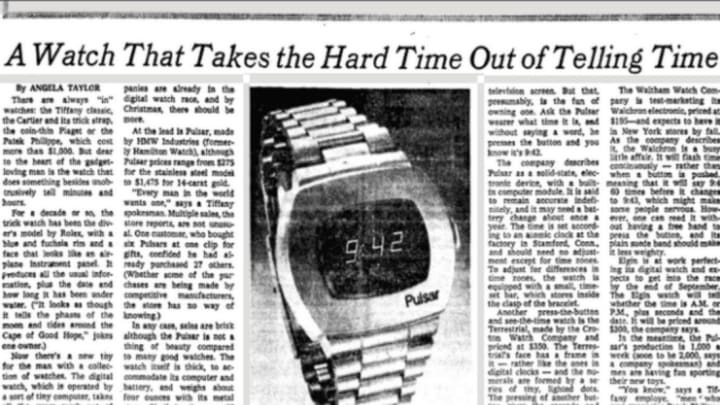Today, Apple is releasing a new entrant to their product line: a watch. As with any Apple unveiling, the business press has been whipped into a frenzy. Will it dominate the watch market like the iPhone conquered its own? Will it put Switzerland out of business? Will it tell time?
In 1973, a watch that used radically advanced technology was introduced in America to curiosity rather than fanfare. Simple digital watches—much like the ones that sit in that little plastic carousel in Walgreens and sell for $4.99 today—seeped into the market. The New York Times noted this peculiar new gadget as "A Watch That Takes The Hard Time Out Of Telling Time."
“Now there’s a new toy for the man with a collection of watches," the Times wrote. "The digital watch, which is operated by a sort of tiny computer, takes all the guess work out of time reading by flashing the hours and minutes in numerals on its face. Several companies are already in the digital watch race, and by Christmas, there should be more.”
The first type of digital watch was the Pulsar ($275 for the steel model, $1,475 for 14-carat gold), made by Hamilton Watches. “The Pulsar is not a thing of beauty compared to many good watches," said the Times. "The watch itself is thick, to accommodate its computer and battery, and weighs about four ounces with its metal strap. Until its ‘command’ button is pressed, it shows nothing but a blank, dark-red face and looks like a dead television screen. But that, presumably, is the fun of owning one. Ask the Pulsar wearer what time it is, and without saying a word, he presses the button and you know it’s 9:42.” Ahh, the Pulsar wearer—that silent scamp.
That digital watches used to have to be activated by pressing a button would seem ridiculous, save for the fact that folks who use their phones in lieu of watches nowadays are very familiar with the process.
The alternative to the "command" button at the time was a real head-scratcher. The Walchron ($195), one of Pulsar's competitors, was "a busy little affair." The Times described its operation thusly: "It will flash time continuously — rather than when a button is pushed, meaning that it will say 9:42 60 times before it changes to 9:43, which might make some people nervous." People's nerves were easily frayed in 1973.
While they appeared to merely be gimmicks upon their initial release, the watch industry had to start taking digital watches seriously. In 1975, the Times reported an "Upsurge In Digital Watches." "The Swiss…are seeking sources for digital mechanisms to not only stem the decline in their own watch industry but also to gear for the future," they wrote.
And even though this new technology was catching on, something about it seemed odd. “In effect," the Times noted, "one does not have to ‘tell’ time as much as simply read it.” There was once a difference?
[via]
